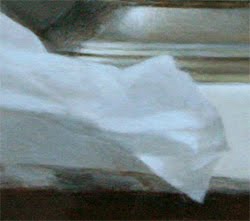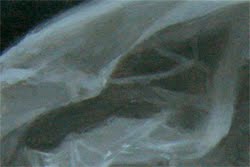
Sterling Boat - DETAIL - work in progress
oil on panel
Today was another 4-hour session and I worked mainly on the spout, handle, and top edge of the pitcher. I managed to take a better photo and so I replaced the photo in yesterday's post too so the color is easier to see. (I didn't send out notifications about yesterday's post because the photo was so bad, so if you are just seeing it today that's why).
In yesterday's post I mentioned "value bracketing" and got a lot of questions about that.
What I mean by value bracketing is taking the time in the first stages of a drawing or painting to block in the value range of each particular area, and then as the drawing progresses, to stay within that initial value range without fail. Some artists assign numbers to values and codes to color, to identify a range and remember to paint or draw within a particular bracket.
For an example of two different areas I mentally bracketed in my current painting, you can see these two areas of wax paper in my current painting are in completely different value ranges:
Top left corner - DARK value range

Low middle area - LIGHT value range
As the painting develops there will be days when I am working on one of these small areas for a whole session, without ever comparing it to another area, so it is tempting to exaggerate the value range in a given area. If I am not disciplined to stay within the value range I've already determined is appropriate, I will make the lights too light in the dark areas, and the shadows too dark in the dark areas.
In the light area of my wax paper in the cropped detail above, the shadows in the creases of the wax paper are bare whispers. In real life it looks like there are huge differences between the shadows in the creases and the bright highlights of white light reflecting off neighboring areas. If I attempt to "copy" that value jump I see, I will make the shadows far too dark and I will destroy the illusion of light in the whole piece.
Our eyes can perceive a much wider range of color and value than paint can ever depict. For example, pure white paint directly from the tube is nowhere near as bright at the lightest highlights on my subject. That's why even the most hyper-realistic painting is still just an illusion, a mere hint of what our eyes can experience in real life.
To capture the sensation of seeing a subject, the artist must preserve the feeling of the whole - how every part relates to every other part. This is so easy to destroy as we zoom in and work closely, because we lose context and we forget that the individual parts, no matter how detailed or realistic, are merely supporting roles to the whole effect.
So I try to depict each edge of each shape with only the smallest value and hue shift I can manage. If I copy the big "jump" I see between two neighboring patches, I will destroy the unity of the painting.
------UPCOMING CLASSES AND WORKSHOPS-----------
I teach Classical Realism drawing and painting classes and workshops in my north light San Francisco studio. I also offer workshops at other locations in the US. Please visit my Teaching page for more information and to register!

